GO TERM SUMMARY
|
| Name: |
positive regulation of blood coagulation |
| Acc: |
GO:0030194 |
| Aspect: |
Biological Process |
| Desc: |
Any process that activates or increases the frequency, rate or extent of blood coagulation. |
Synonyms:
- up regulation of blood coagulation
- stimulation of blood coagulation
- upregulation of blood coagulation
- activation of blood coagulation
- up-regulation of blood coagulation
|
|

|
INTERACTIVE GO GRAPH
|














